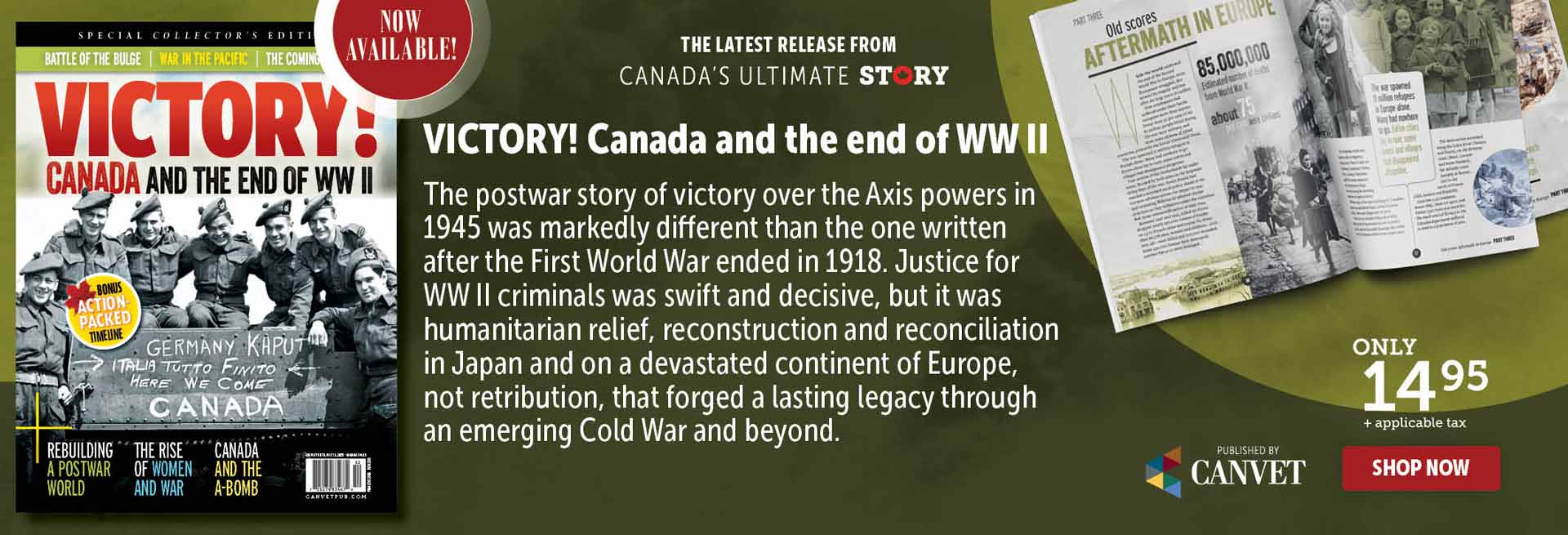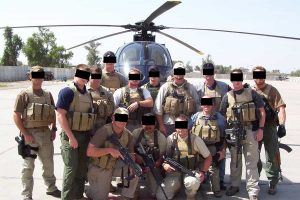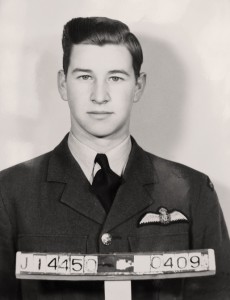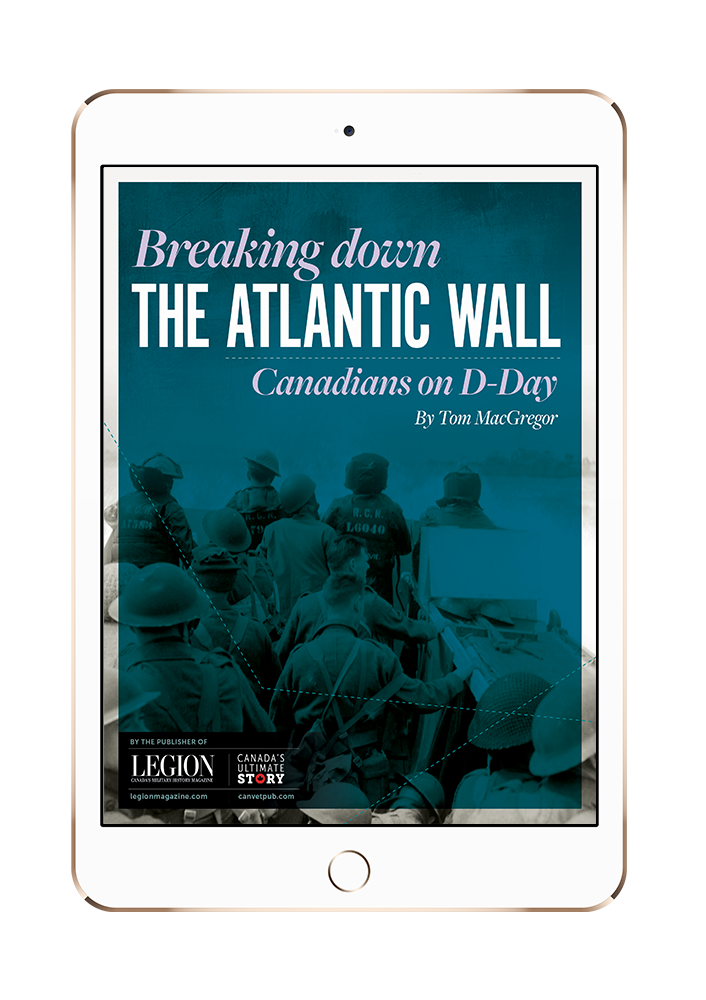
Ronald F. (Andy) Anderson was a company sergeant in the 1st Canadian Parachute Battalion. His diary chronicles the unit’s fight through Belgium during the Battle of the Bulge.
[1st Canadian Parachute Battalion Virtual Museum]
It was Dec. 23, 1944, and the 1st Canadian Parachute Battalion, just created in 1942, was back in England after its baptism of fire on D-Day and through the Normandy campaign. About half the paratroopers who hadn’t been killed or wounded in France had just been issued leave passes.
‘B’ Company Sergeant Ronald F. (Andy) Anderson was reveling in the holiday atmosphere—“the festive air,” as he called it—and looking forward to a rest bit at a family home in Hove, on England’s south coast.
That is until 2 p.m., when a runner from headquarters informed him that that all leave passes were cancelled. He was told to notify his platoon mates and attend a “mass meeting” of battalion brass and senior non-commissioned officers immediately.
British General Sir Richard Nelson (Windy) Gale, a decorated veteran of the First World War and commander of the 6th Airborne Division, of which the Canadians were a part, took the podium.
“It was the General who told the assembly that he was sorry that immediate action had to be taken in the cancellation of leaves,” Anderson wrote in his diary, “but he had been in personal touch with Field Marshal [Bernard] Montgomery, who advised that the military situation in the Ardennes was critical.
“The German Army under [Generalfeldmarschall Gerd] Von Rundstedt had mounted a massive surprise counterattack, mainly on the American Sector, and if not stopped, they could be in Paris within a few days.”
The Battle of the Bulge had begun.
Three dozen divisions—410,000 German troops—had advanced behind an artillery barrage on Dec. 16 in what is widely considered the last gasp of Germany’s retreating Wehrmacht, although Operation Spring Awakening (Unternehmen Frühlingserwachen) on the Eastern Front in March 1945 actually concluded major German offensive actions.
The Germans were backed by just over 1,400 tanks and armored fighting vehicles, 2,600 artillery pieces, and more than 1,000 combat aircraft.
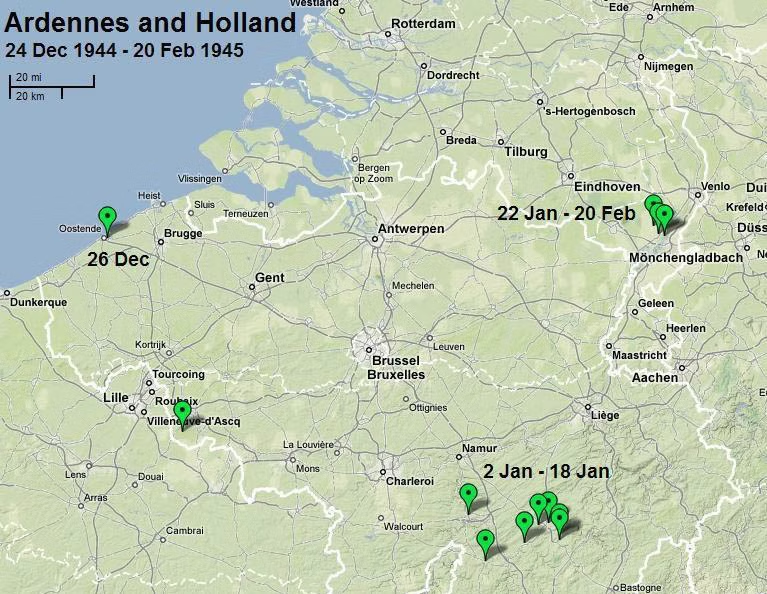
The 1st Canadian Parachute Battalion’s campaign in Belgium and the Netherlands. The Canadian airborne would go on to be among the first paratroopers to jump into Germany.
[Wikimedia]
But it wasn’t the numbers—the Allied force in the region would grow to more than 700,000 by early January—so much as logistics and weather that handicapped the Americans huddled in the Ardennes forest and the Belgian town of Bastogne.
Allied forces had advanced more quickly than anticipated after breaking out from Normandy at the end of July.
Troops were exhausted by weeks of continuous combat and rapid movement; supply lines were stretched thin and food and ammunition were dangerously depleted.
The lack of functioning French railways, destroyed to hamper the German defences before D-Day, were now slowing the Allied advance. The Germans still held key ports and were seeking to take back one of the most important of them all, Antwerp.
Bad weather compounded the Allied issues. Resupply flights were grounded. Reinforcements had to be trucked in.
General Dwight D. Eisenhower, the supreme Allied commander on the Western Front, and his staff decided to hold the Ardennes region primarily to rest the U.S. First Army. The Ardennes line, located in a densely wooded highland with deep river valleys and a sparse road network, was thinly defended.
Intelligence had told them the Wehrmacht was using the German side of the border as a rest-and-refit area. Instead, von Rundstedt reorganized the disrupted German armies into a coherent force.
“The weather over Belgium is closed in fog, and the Met [meteorological] people saw little hope for clearing for some days,” Anderson wrote. “The Camp is closed tight for security.
“The immediate task is to equip all ranks for immediate action, like ammunition, grenades and everything required to step into a frontal position within hours.”
Early on Christmas Eve morning, 1944, the Canadians moved out, boarding “a variety of ships” for the cross-Channel voyage.
“’B’ Company was transported on a troop-carrying vessel which, once in mid-Channel, provided one of the roughest voyages on record,” Anderson wrote. “Many men were sick below decks, which in the closed space made things very messy and smelly.”
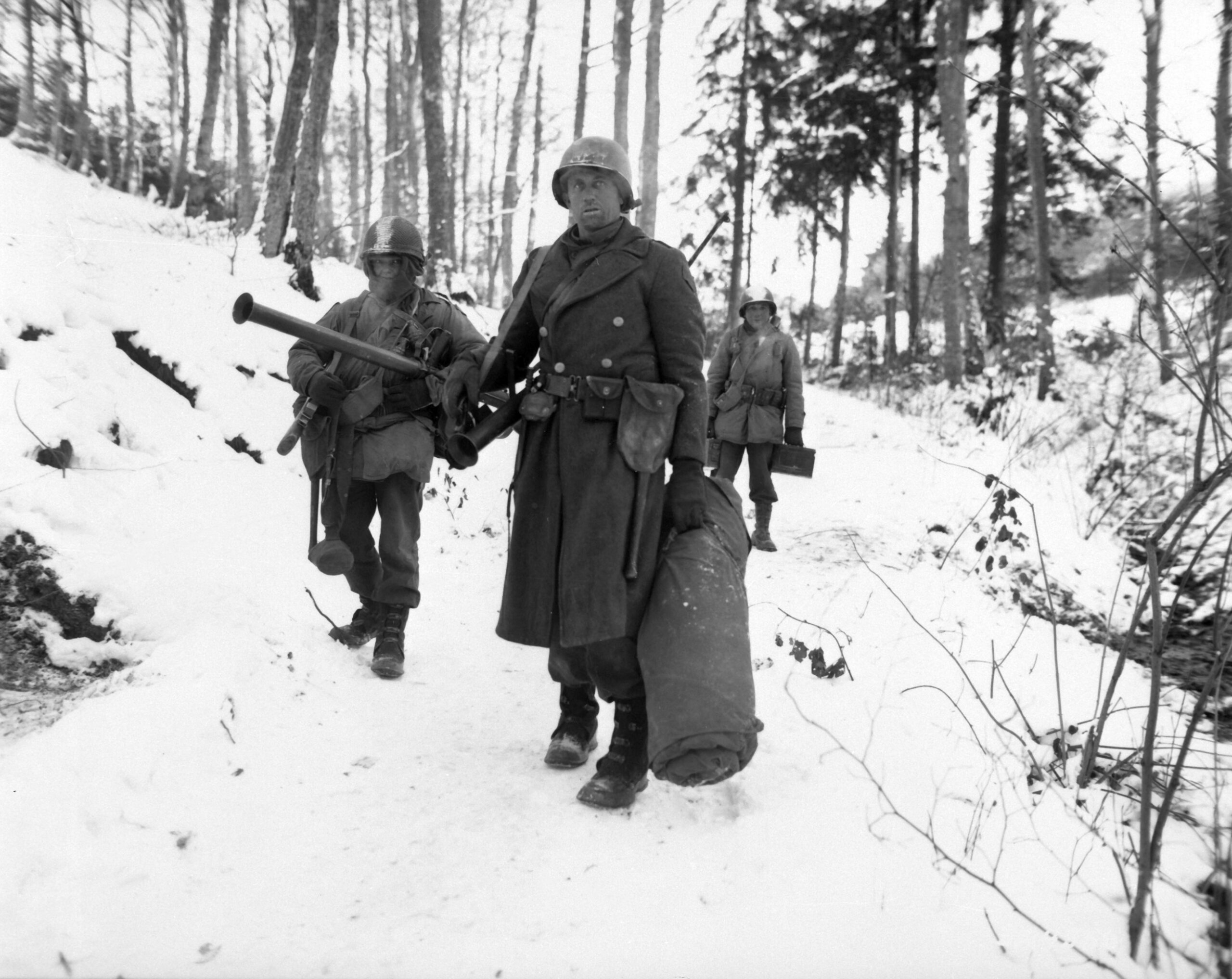
American engineers emerge from the woods as they move out of defensive positions after fighting around Bastogne, Belgium, in December 1944.
[U.S. Army]
“Most of the troops passed them up,” said Anderson who, by the time he got around to updating his diary, couldn’t remember where they landed. He thought it was France, but it was the Belgian port of Oostende.
“It was a quick dockside transfer to trucks, and a fast overland trip” to Rumes, a small town just across the Belgian border, where they bivouacked and awaited orders. “We are short of information, except to be advised that we are close to the action, and we must be prepared to move out at any moment.”
They stayed put Christmas Day, not knowing their next move or when it would come. The men were disappointed and restless, eating rations and whatever could be scrounged locally.
“Not a ‘great’ way to spend Christmas,” Anderson lamented. “What spoils the whole day is the uncertainty of the whole situation.
“In this situation all kinds of rumours are flying and as time goes by, it becomes difficult to ‘keep a lid’ on everything.”
By Boxing Day, it had become evident they’d soon be moving out. They were housed in a small school auditorium, “very cramped quarters, with section piled against section.”
“I have been given orders for all ranks to prime grenades, load ammunition, and do a complete ammunition check, for immediate action,” he wrote. “While standing at the top end of the room, on a small 12” platform, I recall hearing the distinctive ‘ping’ of a striker hitting a grenade primer, and the handle flying.
“At the same time, I heard Sergeant Hill, in charge of No. 5 Section, call ‘grenade.’ I think I yelled get down, or something, but I do recall throwing myself on the floor, at the side of the stage, then in three seconds, the 36 grenade went off, throwing up clouds of plaster, dust, and of course, fragments of the casing.”
“We do not have the tools or the gear. Some men have tried to blow holes in the ground with explosives.”
Anderson got up quickly, patted himself down, and found he had escaped injury. It was the second time he’d encountered a rogue grenade. Before, he hadn’t been so lucky.
“The last time, I did get an ass full of shrapnel, which the nurses in Base Hospital had fun pulling out of me,” he wrote.
As the dust now settled and he recovered his wits, he heard the first cries of the wounded. Hill was the worst hit. He’d stayed next to the grenade, covering his face with his hand, and had lost an eye.
“About six other men are wounded, but none fatally, but all will have to be hospitalized with fragments. The Medics and half the Company came to see what the commotion was, but in retrospect, it is truly remarkable that half the Platoon were not killed outright.”
The incident was still playing itself out when they were ordered to board trucks, headed for they didn’t know where.
Anderson’s next diary entry is Jan. 5, 1945, when after a long move up close to the front “B” Company took up residence at a place called Tavi Farm. The Sections were all out front on what became known as Blueberry Hill.
“The weather is incredibly bad, below zero, high winds, drifting snow and already deep snow on ground,” Anderson wrote. “The orders are to dig in and take strong defensive positions, and naturally we are not equipped for this kind of exercise.
“We do not have the tools or the gear. Some men have tried to blow holes in the ground with explosives, others are simply digging trenches in the snow and covering with gas caps. We are bound to have health problems, especially with frozen feet.
“Some men have obtained burlap sacking and this is wrapped around normal boots; that is what I have done, only after I have managed to freeze my left foot.”
“He told me he had been cleaning his rifle, but at 3:00 a.m. in the morning, under such conditions, it is clearly a self-inflicted wound.”
The troops didn’t know what they were dealing with in terms of enemy. All they’d been told was that their division was holding a line against advancing armour, which was expected to cross the last barrier at Namur, southeast of Brussels.
“This, to say the least, is not heartwarming news. We are essentially shock troops, lightly equipped and armed, hardly in a position to stop a massed armour attack.
“However it has been impressed on us that our orders are to stand and fight at all costs. It is a ‘do or die’ effort, and we cannot count on any support.”
Five days in, still on Blueberry Hill, “we find ourselves in the worst situation we have ever experienced, during the entire war. The men are hungry, cold and frozen, and for my part, moving around from Section to Section has been a painful experience.
“My one foot is frozen for sure, but I dare not remove the boot and wrapping. There is almost no communication with Battalion or Company, and it continues to stay below zero degrees [Fahrenheit].”
The American units, however, had been getting badly needed supplies since Christmas and the battle was turning.
The Canadian sections, anywhere from six to 20 troopers apiece, were manning listening posts well out in front, in blowing snow. “The only way to visit with the men at night is to locate them by compass.”
One night, Anderson heard a shot. He crawled out of his hole, picked up a runner, and set out to determine what was happening.
Pushing through the snowdrifts, he finally found three men dug into a hole covered in a groundsheet. Peering in through the darkness, he saw that one man had shot himself through the lower leg.
“He told me he had been cleaning his rifle, but at 3:00 a.m. in the morning, under such conditions, it is clearly a self-inflicted wound,” Anderson wrote. “Eventually, we had the man carried out and sent back to Company, and I suspect there will be an enquiry, but that will have to wait.
“Thinking later on the subject, I could well imagine a man becoming fed up with conditions, taking any risks to get to shelter, even a barn and some straw. Again, the worst is that I have no information, no communication at higher level, and as far as we know, the threat is still present of a breakthrough.”
“To see young children blown apart in this way, for no apparent reason, is something not easily forgotten.”
They were moved out on Jan. 10 with orders to attack Roy, a German-held Belgian village that today is still home to fewer than 700 people.
“The attack went in as planned but most of the Germans have cleared out,” Anderson wrote. “All we have done is to take a few prisoners, but best of all, we have holed up in a farmhouse and some men start to scrounge for food and some kind of stoves. The Belgian people still on the farm are not too kindly disposed to us.
“I have no idea if this is the case with all Belgians, but I am reminded of stories my father told of his first war, and some bad experiences with the Belgians. But I should not rush to judgement, just a few days here to clean up, get warm and I think our spirits will return.”
Still, the grunts were uninformed of the general situation, what they were facing, how other units had fared, and what their immediate future held. Anderson called it annoying and unusual, contrary to the brigade’s long-held principle of “keeping everyone in the picture.”
On Jan. 12, he was summoned to company headquarters and told to select five men from the platoon who were to form part of a larger battalion group. Their job was to bear witness to the laying out of some 37 bodies of Belgians murdered by German troops.
“It appears that these bodies were discovered by our troops, quite by accident, in the cellar of a garage,” he wrote. “The German troops apparently interrogated them all, men, women and children, then threw them into the cellar through a hole in the floor, where they then threw grenades on top of them.
“The bodies are terribly mutilated, but part of the observation is to witness the extraction of the bodies and to witness the identification by family and friends. Naturally, the scene was highly emotional; bodies are not a new experience, but to see young children blown apart in this way, for no apparent reason, is something not easily forgotten.”
He was told the incident was the work of the SS, or Schutzstaffel—Hitler’s fanatical personal army—and the 14th Panzer Grenadiers. “I think the inference was that we were to remember these units for the future.”
And still it was cold, with lots of snow.
On the 14th, they were moved again, closer to the action in Rochefort, where they relieved American troops who had been “badly shot up since Christmas.”
The Yanks had been “run over with heavy armour, and some of our troops and the citizens have spent days hauling American bodies on Ox Carts to grave registration points. It was an odd sight to see frozen bodies, stripped of boots, stacked like cordwood, with perhaps 20 bodies to a cart load.”
The survivors were understrength and requiring rest and reinforcement. The situation was still not stabilized and the enemy strength was not known.
And still it was cold, with lots of snow.
The 6th Airborne was involved in serious fighting, even hand-to-hand combat, and took heavy casualties.
“One of the points that has been impressed on us from the day we arrived, and more so in this location, is that German troops in a special company, speaking perfect English and wearing American uniforms, have been driving jeeps into the lines, netting information, doing sabotage and generally raising hell.”
Outposts had been warned, and ordered to change passwords and question American-uniformed troops about baseball, movies and current slang.
“The very thought of these men loose in our rear areas is extremely upsetting.”
On the 17th, Anderson led a nighttime fighting patrol of 30 men six kilometres to the next town where, faces blackened and weighed down with grenades and ammo, they were to make contact with the enemy, determine their strength, and fight and bring back prisoners if discovered.
It went off without a hitch. The town, they determined, was only lightly defended. No encounter took place. Nevertheless, they returned to the lines “completely exhausted.”
Three days later, they moved on to a rest area in the Netherlands.
“Our present position is in a farmhouse, right on the bank of the Maas river,” Anderson wrote on Jan. 22. “Surveying my Platoon position, I found that the Germans are dug-in right across the river, and from the maps I discover that we are about eight miles from the German border.
“Two things were evident,” he added. “First the Germans are perhaps as exhausted as we are, and secondly, they are prepared to make a full stand along this wide river, which is a considerable barrier.
“This is hardly a rest area.”
Advertisement






